Sierra Designs Whitney Down Hoodie

The Sierra Designs Whitney Hoodie is a fairly lightweight but warm layer. The Whitney has a semi-athletic fit that allows for some layering and mildly affected freedom of movement in the shoulders for me. Filled with quality 800 fill power DriDown, the Whitney has a pretty nice set of features, particularly for its price point ($159 retail). It's a great outer layer for fall/early winter and hiking breaks in colder weather, or as a mid-layer under a shell in cold weather. A versatile, quality down jacket.
Pros
- Warm
- Reasonably lightweight (14.4 oz., men's XL)
- Excellent sleeve/cuff design
- Solid features
- DriDown is a plus
- Price
Cons
- Semi-narrow fit can limit layering and mobility
- Main zipper and chest pocket would benefit from pull cords to use with gloves on
March 2025 update:
In perhaps the ultimate sign Sierra Designs got it right with this jacket, our outdoorsy son took it when he went to grad school. Here is a photo of him wearing it today in Turkey, where he’s traveling this week.

original 2022 review:
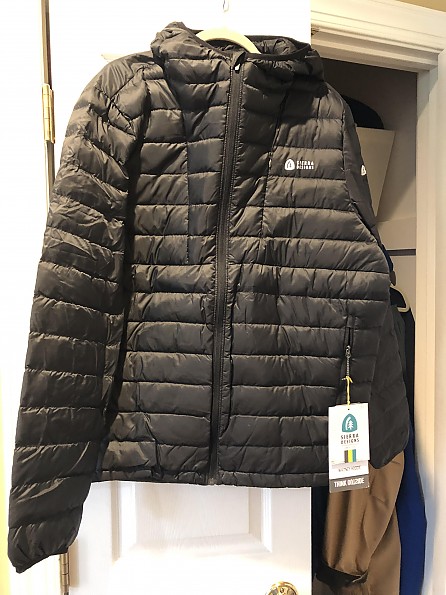
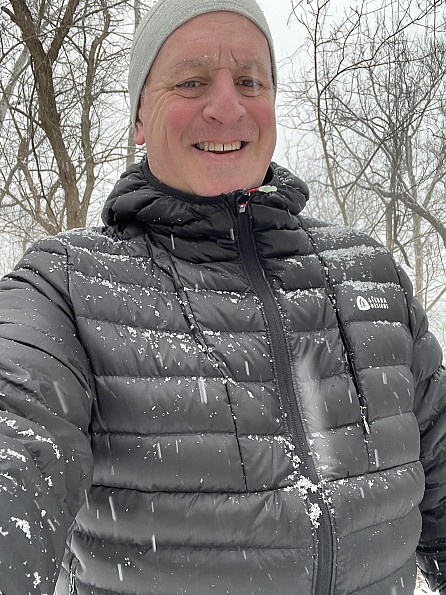
INTRODUCTION/BASIC INFORMATION:
I have had Sierra Designs’ Whitney Hoodie for testing since October and have had ample opportunity to wear it from temperatures in the low 40s through the teens. I like the versatility of this jacket. It's warmer than down sweaters and ultralight lightweight down jackets, so it works well into the winter, depending on where you are, yet it's a lighter and lower-profile than a jacket I would normally bring on an overnight winter hike, so it's a good option for winter days that aren't frigid or for use as a lightweight mid-layer under a shell.
It's also appealing due to the features and warmth it provides for a very reasonable price. Men‘s sizes run from small through 2XL, and the women’s version runs from XS through XL. My men’s size XL weighs 14.4 ounces on a digital hand scale, and the jacket runs true to size—I don’t recommend sizing up or down, but will address fit In more detail below. If you prefer jackets without hoods, check out the Sierra Designs Sierra Jacket—it looks the same, though I don’t know if the features are identical.
The Whitney is filled with 800 fill power DriDown. Sierra Designs says a men’s large has 5.6 ounces. Fill power is a measure of how much the insulation lofts. The higher the number, the more loft per ounce of down. Typically, 600-700 fill power down is in lower priced down jackets, fashion brand jackets that aren’t focused on hiking, or big/heavy down jackets with a lot of fill that are made for spending a fair bit of time out in the cold but aren’t intended to stuff into a backpack.
800+ fill power is in down jackets where companies are trying to maximize the ratio of warmth to weight, minimize the space a down jacket will occupy when it’s packed, or for deep winter weather where you need a lot of insulating value but also need to carry the jacket on your back when you aren’t using it. The Whitney is made with hiking in mind, given it’s relatively low weight and higher-loft down. It could be a good option for skiing, but consider bringing a shell in case the stitching in front lets in more air than you want.
The outer shell is made from 30 denier polyester, and the lining is nylon. that’s pretty typical for a down jacket that is stitched through, meaning the stitching that holds the inner and outer layers in place and creates the "tubes" that keep the down from shifting around runs through both layers of fabric. [a warmer but heavier construction has separate pieces of fabric, baffles, sewn in between the inner and outer layers to allow the insulation additional room to loft and keep you warm].
30D polyester is reasonably robust these days—the lightest jackets use 10D nylon or polyester. Sometimes, there are trade-offs between weight and durability, the ability to avoid rips and tears, so I expect the Whitney’s outer shell will tend to be more durable than ultralight puffy layers.


The Whitney has a good set of features for a relatively inexpensive ($159) down layer. The jacket has:
- a down-filled hood with elastic trim but no other adjustments;
- a small zippered chest pocket;
- two zippered/unlined hand warmer pockets. The hand pockets both have good, lightweight string pulls that make them easier to use with gloves on; it made me wonder why Sierra Designs didn’t put the same pulls on the main zipper and chest pocket;
- inside, two large drop-in pockets (store a light hat, glove liners, snacks);
- the hem has an adjustable shock cord that’s easy to use and attached to the jacket. It doesn’t dangle, which is good;
- hang loop at the back of the neck so you can leave it on a coat hook if you want.
Zippers all work smoothly, and there is a draft flap behind the main zipper. The jacket stuffs into one of the handwarmer pockets and is the size of a small pillow—like two liter-sized water bottles but squishy.

The cuffs are unusual and worth special mention. In addition to elastic on the outer cuff, each sleeve has an inner stretchy fabric cuff. It’s a design I haven’t seen in any other jacket and does a better job sealing cold and snow out than any comparable down jacket I have worn. Because it’s so different, some people may not like how it feels—worth trying it on if you have a concern. I liked it. As you can see, both cuffs are very low profile, elastic but not thick, so it didn't interfere with gloves.


FIT
The Whitney has a somewhat athletic fit. I normally wear men’s XL, and this jacket was definitely the right size for me. It has enough room for me to wear a heavyweight base layer underneath, but it doesn’t have enough space for a mid weight fleece too.
I also found the range of movement in the shoulder area to be somewhat limited by the relatively narrower profile of how this jacket is cut. This is most apparent when I raise my arms high or reach back. For regular walking or as a warm layer to pull on when you’re sitting still, it’s not an issue. Sleeve and hem length are average.
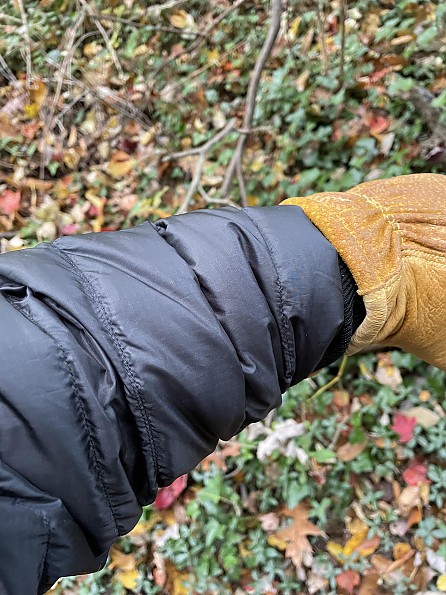
The design of the front, upper chest area, is interesting. Each size has an extra row of vertical stitching, almost parallel to the main zipper. It might have been intended to limit down shifting around in the chest area, a plus, but it’s also an extra place for the stitched-through jacket to allow cold wind to penetrate. (I referenced this above regarding skiing. I would probably stuff a light wind shell into one of the pockets if I were skiing in the Whitney, just in case).



The hood has a good amount of down fill. The elastic around the edge of the opening is fine but leaves some gaps, and the hood is not adjustable. The gapping may be a product of the fact that it’s large enough to handle a low-profile helmet; it was just a bit tight over my cycling helmet, which is pretty large, and that eliminated gaps around the edge of the hood opening. Without a helmet, I’m not sure it would stay in place on a windy day, but I didn’t wear it in any really high wind (in 10-15 mph wind, it didn’t blow off my head, though).
WARMTH
The Whitney is nicely warm for its relatively light weight. I tended to bring it in a backpack and put it on during breaks when I was hiking, but I also wore it in a number of situations where is was standing still or not moving much—college football game, mid-30s and breezy; standing around in mid-20s while our dog ran around with a dozen or more other dogs on a field, walking the dog when she was more interested in sniffing the daisies than going at any particular pace. Particularly with the hood on, it kept me cozy.

The jacket should keep you warm even if mist, drizzle, or minor snow melt gets the insulation wet because DriDown has a hydrophobic treatment; it’s made to resist wetting out longer than regular down. The outer nylon shell is treated with water repellant, so it should protect the down from light rain.
A storm this weekend gave me some opportunities to test whether DriDown really works. During the day temperatures were in the mid-20s, and snow fell steadily to accumulate a few inches. I hiked roughly 3 miles in the Whitney. I normally don’t hike in puffy down jackets, they’re too warm for me, but I wanted to see if heavy perspiration would collapse the down fill. It was too cold for the snow to melt on the outer shell; the inner surface was damp by the end of the hike. The down didn’t collapse or seem affected.
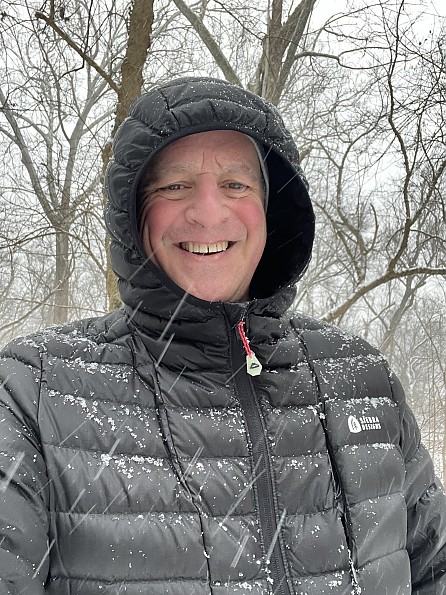

As often happens in the mid-Atlantic, the temperature rose and the storm turned into sleet, then rain. I went outside for about 20 minutes, to the point that I thought the rain, which was somewhere between steady and hard, would defeat the DWR on the outer shell.

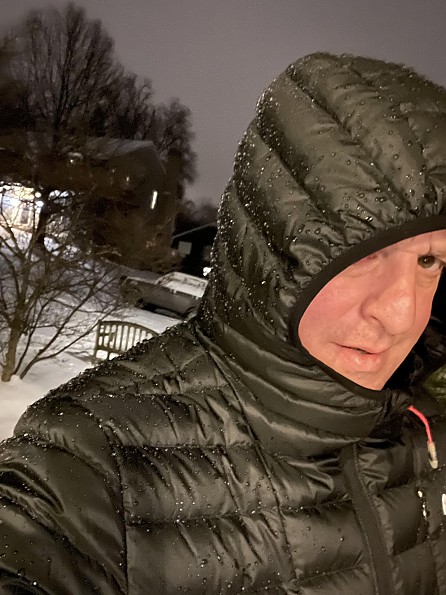

As the photos show, there was quite a bit of water on the shell. It beaded up pretty well, considering, but the shell felt wet all over, not just where you can see drops on it—it was quite wet. As you can see, the down was still lofting well.
I have, on a few unfortunate occasions, slept in down sleeping bags that got wet enough to collapse the down. That severely limits the bag’s insulating ability. Synthetic puffy fill provides more warmth when wet because the fibers don’t collapse nearly as much as down if they get soaked. DriDown should be better than untreated down, but I don’t know if it’s on par with synthetic fills when it gets really wet. I think that if you use reasonable judgment, like wearing a rain shell over a down jacket if it really starts raining hard, DriDown is a good product that will prolong your ability to stay warm in marginal or wet weather.

My take is that with the limited room for layering underneath, the Whitney is comfortable spending quality time outside into the 20s Fahrenheit, and the low 20s worn under a hard shell, and it’s fine to the low 40s depending on what you wear underneath and how active you plan to be.
On colder day hikes, in the teens, it was a nice layer to pull on for a short stop, but I felt like I was pushing the limits of this jacket at that point. For persistent cold below 20, I recommend looking at a thicker/warmer down jacket.
CONCLUSIONS/TAKEAWAYS
Sierra Designs is giving you an awful lot for the price with the Whitney. High-quality down that can handle some rain or snow melt, light weight, features you don’t often find at this price. It’s definitely worth a look if you want a light to medium-warm jacket to either extend your three-season insulation or as an added warm layer for winter outings where you’re active, that’s also light and packable. I pulled this on for snack breaks during winter hikes, and I could definitely see using it for breaks on Nordic skiing outings in cold weather.
Background
2+ months of wear from October through the New Year in the mid-Atlantic, Michigan, and New England.
Source: received for testing via the Trailspace Review Corps
(Sample for testing and review provided by Sierra Designs)
Your Review
Where to Buy
You May Like
Specs
| Men's | |
|---|---|
| Price |
MSRP: $189.95 Current Retail: $75.98-$115.49 Historic Range: $75.98-$199.00 |
| Weight |
13.77 oz / 390 g |
| Center Back Length |
23 in / 58.42 cm |
| Sleeve Length |
37.75 in / 95.89 cm |
| Insulation |
800 Fill RDS DriDown with PFC Free DWR |
| Shell |
50% Recycled Nylon, 50% Nylon Ripstop with DWR finish |
| Liner |
100% Nylon |
| Women's | |
|---|---|
| Price |
MSRP: $189.95 Current Retail: $66.48-$115.49 Historic Range: $64.08-$199.00 |
| Weight |
12.36 oz / 350 g |
| Center Back Length |
27.75 in / 70.49 cm |
| Sleeve Length |
35 in / 88.9 cm |
| Insulation |
800 Fill RDS DriDown with PFC Free DWR |
| Shell |
50% Recycled Nylon, 50% Nylon Ripstop with DWR finish |
| Liner |
100% Nylon |


